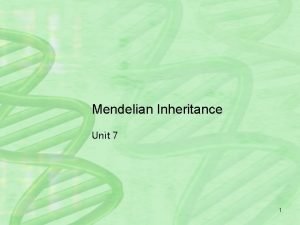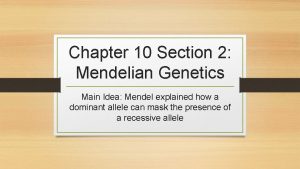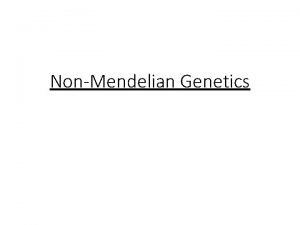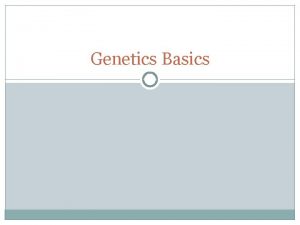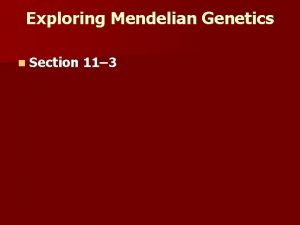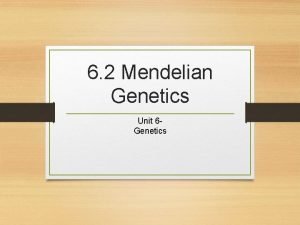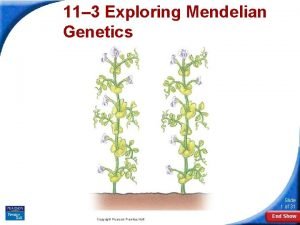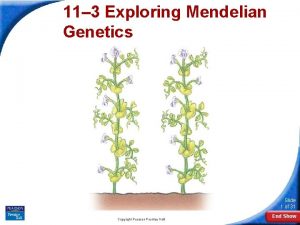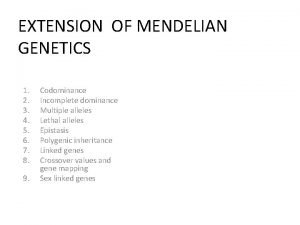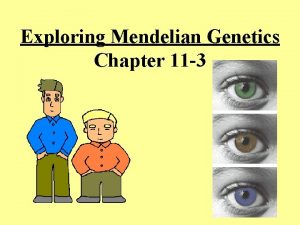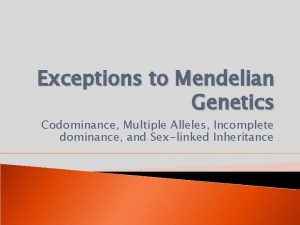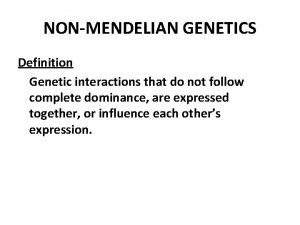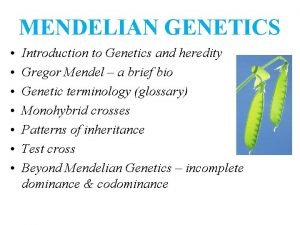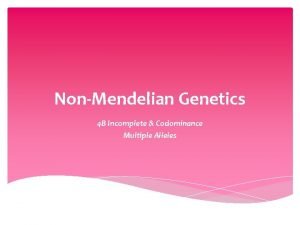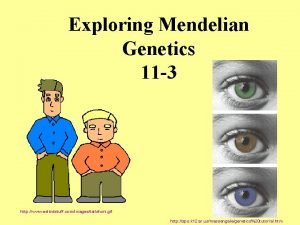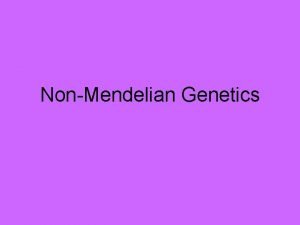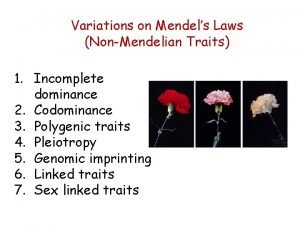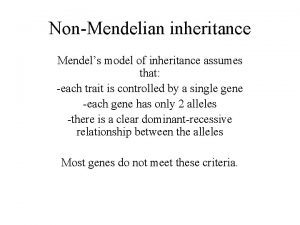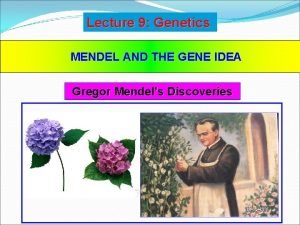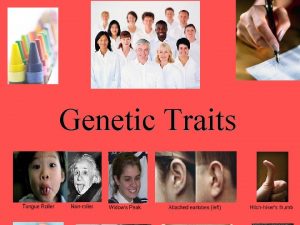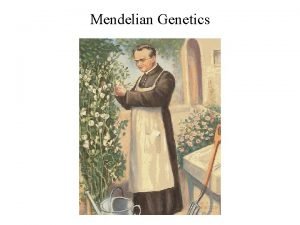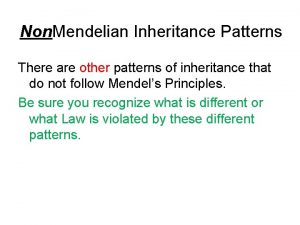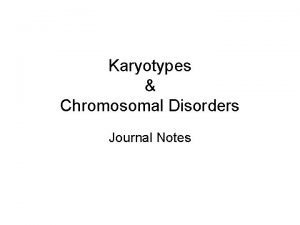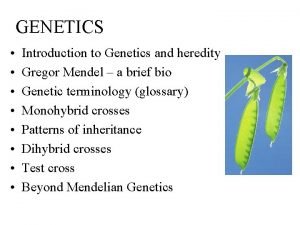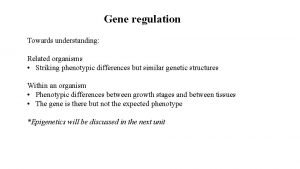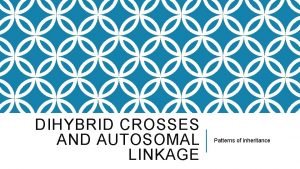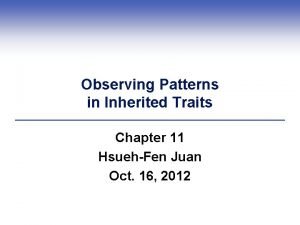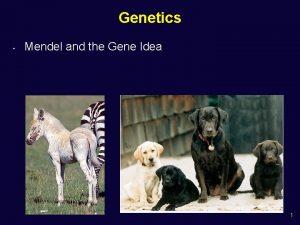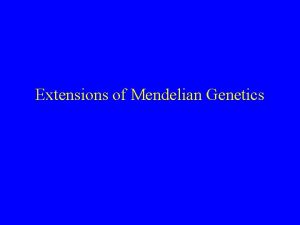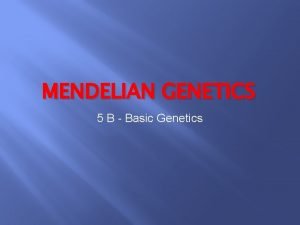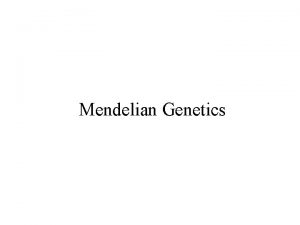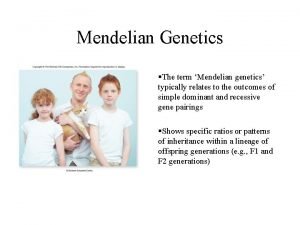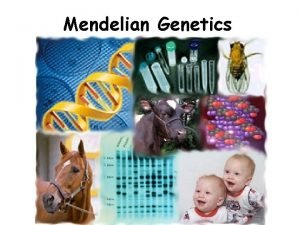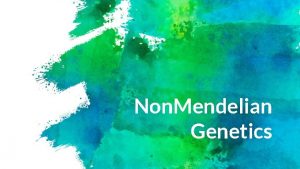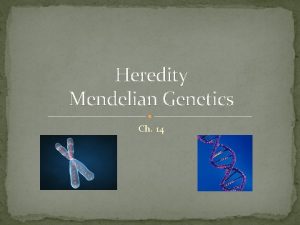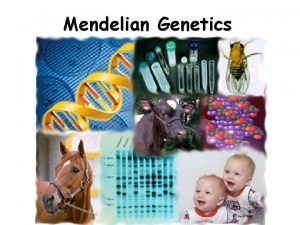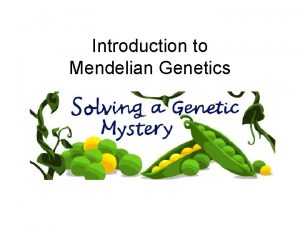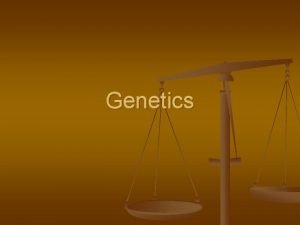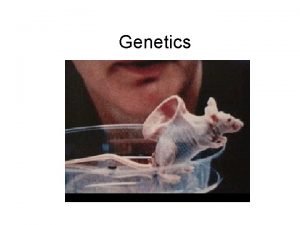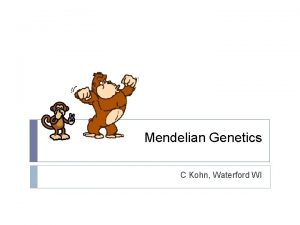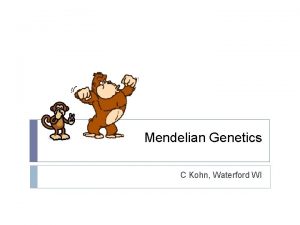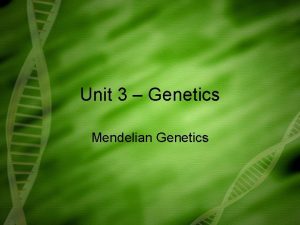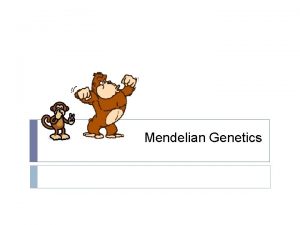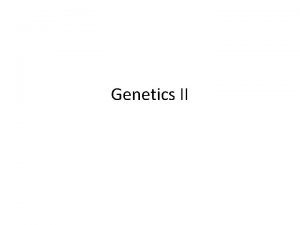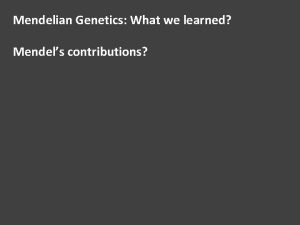Chapter 11 Notes Mendelian Genetics Genetics is the













































- Slides: 45

Chapter 11 Notes: Mendelian Genetics • Genetics is the scientific study of heredity that involves how genes are passed from parents to their offspring.

History of Genetics • Gregor Mendel was an Austrian monk and scientist who was in charge of the monastery garden. Mendel studied garden peas.

Pea plants happened to be a good choice to study because: – They are self-pollinating. – He had different pea plants that were truebreeding. – True-breeding - means that they are homozygous for that trait. – EX. if the plants self-pollinate they produce offspring identical to each other and the parents.

Pea plants happened to be a good choice to study because: – He developed a technique of producing seeds from a process called crosspollination, in which he dusted the pollen of one pea plant onto another plant. – He was in control of which plants crossed with each other.

Genes and Dominance • A trait is a specific characteristic that varies from one individual to another. • Mendel studied seven different pea plant traits including seed shape, seed color, seed coat color, pod shape, pod color, flower position, and plant height. – Mendel studied two alleles, or different versions, of each trait (wrinkled or smooth pea shape, green or yellow seed color, etc. )

When discussing generations’ traits, we label them as following: • The true-breeding parental generation is called the “P generation”. • The offspring of the two parental plants is called the “F 1 generation”. • A cross between F 1 generation would be called “F 2 generation. ”

Original cross Cross pollination

Mendel’s Investigations • Mendel wanted to cross (or breed) two plants with different versions of the same trait. He wanted to know if the characteristics of the plants were blended in the offspring.

Mendel’s Investigations • Mendel saw that when he crossed plants with different versions of the same trait (P generation), the F 1 offspring were NOT blended versions of the parents. • The F 1 plants resembled only one of the parents. Tall x short all tall…

Mendel concluded: • 1. Biological inheritance is determined by “factors” that are passed from one generation to the next. • Factors were later defined as “genes”– Mendel discovered all of this without the knowledge of DNA!

Mendel concluded: • In Mendel’s plants, there was one gene for each trait. For example, there was one gene for plant height. – But, there were two versions of this gene: one for a tall plant and one for a short plant. – Alleles: Different versions of the same gene • Remember, genes are used to make proteins. • Each allele contains the DNA that codes for a slightly different version of the same protein • This gives us the different characteristics for each trait

2. Principal of dominance: • Some alleles are dominant and some alleles are recessive. – Recessive alleles are able to be masked – Dominant alleles mask recessive alleles • The trait that was represented in the F 1 generation was the dominant trait.

2. Principal of dominance: • How many alleles do you have for each gene? • Where do they come from?

3. Segregation: • Experiment: Mendel self-pollinated the F 1 plants, or crossed the F 1 plants with each other, to produce the F 2 generation. From his F 1 crosses, Mendel observed: – The versions of the traits coded for by recessive alleles reappeared in the F 2 plants. – The recessive trait was still there!

3. Segregation: – About 25% (or ¼) of the F 2 plants exhibited the recessive version of the trait. In this case the recessive phenotype is short. The dominant phenotype, tall, was found in 75% (or ¾) of the F 2 plants. P generation F 1 generation F 2 generation

Segregation of alleles during meiosis: • When the F 1 plants produce gametes (sex cells) and self-pollinate, the two alleles for the same gene separate from each other so that each gamete carries only one copy of each gene. • Remember, gametes are haploid. In the example, we use “T” to represent the dominant, tall allele and “t” to represent the recessive, short allele.

4. Law of Independent Assortment • Law of Independent Assortment- genes for each trait can be inherited independently from each other. For example – not all tall plants have green pea pods and – not all people with brown hair have brown eyes.


Key Terms in Mendelian Genetics: • Dominant- allele that can mask; represented by capital letters (B, D, F, etc. ) • Recessive- alleles that can be masked; represented by lower case letters (b, d, f, etc. )

Key Terms in Mendelian Genetics: • Phenotype- observable traits (brown eyes, yellow seed pods) • Genotype- actual alleles; describes the genetic characteristics (BB, dd, Ff) Phenotype: brown eyes Genotype: could be BB, or Bb

Key Terms in Mendelian Genetics: • Homozygous (True-Breeding)- having two identical alleles for the same trait (TT, tt); “homo” means same • Heterozygous- having two different alleles from the same trait (Tt); “hetero” means different

• Punnett Squares must be taught before continuing

Beyond dominant and recessive alleles • There are some exceptions to Mendel’s principles. Luckily, none of these exceptions are exhibited in pea plants. • If so, Mendel would not have been able to figure out inheritance.

• Some alleles are neither dominant nor recessive. – Incomplete Dominance – Codominance

Incomplete dominance: • situation in which one allele is not completely dominant over another; the phenotype is a “blending” of the two alleles – Example: In some plants, when a truebreeding plant with red flowers is crossed with a true-breeding plant with white flowers, pink flowers are produced. Neither red nor white is dominant over the other.

• Consider this Punnett square:

Codominance: • situation in which both alleles of a gene contribute to the phenotype of the organism; both alleles are expressed but NOT blended – Example: In cows, the allele for red fur is codominant with the allele for white fur. Heterozygous cows carrying one red and one white allele have spotted fur, known as roan.

• Consider this Punnett square:

• Many traits are controlled by multiple alleles or multiple genes. – Multiple alleles (more than 2 choices) – Polygenic (multiple genes control a single trait)

Multiple alleles: • the case where three or more alleles of the same gene exist. Remember, an organism will have only two of these alleles (one from mom and one from dad). – Examples: Coat color in rabbits, blood type in humans

Multiple alleles:

Polygenic traits: • traits that are determined by alleles from more than one gene; these traits usually have a range of phenotypes – Examples: skin color in humans, height in humans

Mapping Genes • It’s easy to imagine that genes on different chromosomes assort independently, but what about genes that occur on the same chromosome? Don’t they always appear together? • Not always due to crossing over. Genes that occur together on a chromosome will be separated when homologous chromosomes exchange genes. • The frequency of genes occurring together can help us generate a gene map.

• The more often two genes occur together, the closer they are to each other on the chromosome. – If the genes are never separated by crossing over, they always occur together. All offspring will look like one of the parents (in reference to the genes in question).

– If half of the offspring are parental and half are recombinations of the parents (in reference to the genes in question), then they are said to be independent. This means they are either on separate chromosomes or they are almost always separated during meiosis. – You will learn to calculate distances and create a map in AP Bio, or in college


Human chromosomes 2. There are two types of chromosomes. a. Autosomes: Of the 46 chromosomes, 44 of them (22 pairs of chromosomes) are called autosomes (non-sex chromosomes). b. Sex chromosomes: The last two chromosomes are called the sex chromosomes because they determine the sex of the person. Females have two X chromosomes (XX) and males have one X and one Y chromosome (XY).

3. Gametes a. All gametes are haploid. In humans, that means each egg cell and each sperm cell has 1 copy of each chromosome for a total of 23 chromosomes. i. Egg cells: All human egg cells carry 23 chromosomes, one of which is a single X chromosome. This is written as 23, X. ii. Sperm cells: In males, there are two types of sperm cells- one carries an X chromosome (23, X) and one carries a Y chromosome (23, Y).

iii. When a sperm and egg cell combine, half of the time the fertilized eggs (also called zygotes) are female (46, XX) and half of the time they are male (46, XY). X Y sperm X X XX XX female XY XY male eggs

• Sex Linked traits: traits that are determined by alleles that are found on the X or Y chromosome. – The Y chromosome is shorter and does not carry all the same alleles as the X chromosome.

– Females are XX and males are XY. – Females can be homozygous or heterozygous for a trait carried on the X chromosome, but males (having only one X chromosome) are hemizygous.

– If they inherit a defective gene from the parent, then they will exhibit the trait because they cannot inherit a second gene to mask it. – Conversely, a healthy male cannot be “hiding” a bad recessive allele because they only have one X chromosome.

Example of a sex-linked Punnett square: – XBXb (heterozygous female with normal vision) crossed to XBY (hemizygous male with normal vision) XBY XB XB Xb Xb Xb. Y

Genetics and the Environment • Characteristics are determined by both genes and the environment. • External: While genes will influence the height of a plant, the amount of water, sun, and other climate conditions will also affect the height.

Genetics and the Environment • Internal: There are recent findings that proteins involved with DNA can turn genes on or off based on environmental factors. – Certain chemical exposure can turn genes on or off (make the traits show up or not) for generations after exposure, but there are no changes to the DNA (no mutations). – This new understanding of how genes are expressed is called epigenetics.
 Family resemblance test
Family resemblance test Chapter 7 extending mendelian genetics answer key
Chapter 7 extending mendelian genetics answer key Chapter 10 section 2 mendelian genetics
Chapter 10 section 2 mendelian genetics Identify the disorder
Identify the disorder What is inside a chromosome
What is inside a chromosome Chapter 7 extending mendelian genetics vocabulary practice
Chapter 7 extending mendelian genetics vocabulary practice Non mendelian genetics multiple alleles
Non mendelian genetics multiple alleles Section 11-4 meiosis answer key
Section 11-4 meiosis answer key What is heterozygous type b blood
What is heterozygous type b blood Section 11-3 exploring mendelian genetics
Section 11-3 exploring mendelian genetics Mendelian genetics punnett square
Mendelian genetics punnett square Section 11-3 exploring mendelian genetics
Section 11-3 exploring mendelian genetics 11.3 exploring mendelian genetics
11.3 exploring mendelian genetics Karyotype
Karyotype Extension of mendelian genetics
Extension of mendelian genetics Section 11-3 exploring mendelian genetics answer key
Section 11-3 exploring mendelian genetics answer key Hors xnxn
Hors xnxn Phenotype simple definition
Phenotype simple definition Codominance example
Codominance example 3 laws in law of inheritance
3 laws in law of inheritance Pedigree miscarriage symbol
Pedigree miscarriage symbol Chromosomes and alleles
Chromosomes and alleles Mendelian genetics vocab
Mendelian genetics vocab Codominance definition
Codominance definition Mendelian genetics concept map
Mendelian genetics concept map Eslkidstuff
Eslkidstuff Mendelian ratios
Mendelian ratios Non mendelian inheritance
Non mendelian inheritance Mendelian randomisation
Mendelian randomisation Non mendelian law
Non mendelian law Non mendelian law
Non mendelian law Cystic fibrosis mendelian inheritance
Cystic fibrosis mendelian inheritance Mendelian traits
Mendelian traits Postulat mendel
Postulat mendel Probability laws govern mendelian inheritance
Probability laws govern mendelian inheritance Mendelian inheritance patterns
Mendelian inheritance patterns Difference between mendelian and chromosomal disorders
Difference between mendelian and chromosomal disorders What is punnett square
What is punnett square Homozygous
Homozygous Recessive epistasis definition
Recessive epistasis definition Dihybrid cross
Dihybrid cross Mendelian traits
Mendelian traits Mendel
Mendel Mendelian
Mendelian Baldness genotype
Baldness genotype Conversion notes brutes en notes standard wisc 5
Conversion notes brutes en notes standard wisc 5
